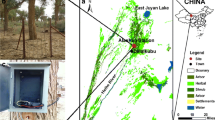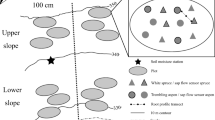Abstract
Key message
We demonstrate the negative impacts of ground thaw on sap flow in black spruce. Climate warming is accelerating permafrost thaw; our study may inform observed warming-related productivity declines in subarctic forests.
Abstract
Many of Canada’s northern boreal peatlands are situated on discontinuous permafrost. Here, permafrost provides the physical foundation on which forests persist. However, climate warming is leading to increased rates of permafrost thaw resulting in both increased active layer thickness (ALT) as well as shrinkage of the area underlain by permafrost due to lateral thaw at plateau margins. Such changes to the substrate likely impact growth and physiological processes of the trees. Despite this, little is known about the role of active layer development, and changes to it, including thaw of the underlying permafrost on tree water relations. Here, we measured sap flow in black spruce from a peatland experiencing rapid permafrost thaw and quantified drivers of changes in sap flow. Time series analyses revealed that of the environmental drivers examined, vapour pressure deficit was the strongest predictor of diurnal sap flow, while seasonal patterns were driven largely by energy inputs; however, the environmental drivers of importance did not change as a function of ground thaw conditions. To understand the implications of changing permafrost and active layer conditions, we quantified differences in sap flow between trees in interior positions of permafrost plateaus and trees on degrading plateau edges. We found >65 % reductions in sap flow in edge trees, attributable to reduced root function at waterlogged edges. Seasonal thaw processes also influenced sap flow. Paired measures of ALT indicated a negative linear relationship with sap flow that was stronger for interior trees. Greater ALT, which corresponds with deeper frost and water tables reduced sap flow by up to 60 % and is likely attributable to drying in surface soil layers where rooting occurs. Climate warming will accelerate permafrost thaw, which our data suggests will drive decreases in the productivity of black spruce-dominated subarctic forests. These findings may thus enhance our understanding of widespread reductions in productivity in boreal forests in northwestern North America.








Similar content being viewed by others
References
Aerts R (2006) The freezer defrosting: global warming and litter decomposition rates in cold biomes. J Ecol 94:713–724
Baltzer JL, Veness T, Chasmer LE, Sniderhan AE, Quinton WL (2014) Forests on thawing permafrost: fragmentation, edge effects, and net forest loss. Glob Change Biol 20:824–834
Beilman DW, Robinson SD (2003) Peatland permafrost thaw and landform type along a climatic gradient. In: Proceedings of the 8th international conference on permafrost. Balkema Publishers, Zurich, pp 61–65
Blanken PD, Black TA, Yang PC, Neumann HH, Nesic Z, Staebler R, Hartog G, Den Novak MD, Lee X (1997) Energy balance and canopy conductance of a boreal aspen forest: partitioning overstory and understory components. J Geophys Res 102:28915–28927
Bovard BD, Curtis PS, Vogel CS, Su H-B, Schmid HP (2005) Environmental controls on sap flow in a northern hardwood forest. Tree Physiol 25:31–38
Box GEP, Jenkins GM (1976) Time series analysis: forecasting and control. Holden-Day, San Francisco
Brockwell PJ, Davis RA (2002) Introduction to time series and forecasting, 2nd edn. Springer, New York
Burgess SSO, Adams MA, Turner NC, Beverly CR, Ong CK, Khan AAH, Bleby TM (2001) An improved heat pulse method to measure low and reverse rates of sap flow in woody plants. Tree Physiol 21:589–598
Burnham KP, Anderson DR (1998) Model selection and inference: a practical information theoretic approach. Springer, New York
Camill P (2005) Permafrost thaw accelerates in boreal peatlands during late-20th century climate warming. Clim Change 68:135–152
Camill P, Chihara L, Adams B, Andreassi C, Barry A, Kalim S, Limmer J, Mandell M, Rafert G (2010) Early life history transitions and recruitment of Picea mariana in thawed boreal permafrost peatlands. Ecology 91:448–459
Campbell TA (1980) Oxygen flux measurements in organic soils. Can J Soil Sci 60:641–650
Cermak J, Kucera J, Nadezhdina N (2004) Sap flow measurements with some thermodynamic methods, flow integration within trees and scaling up from sample trees to entire forest stands. Trees 18:529–546
Fisher JB, Whittaker RJ, Malhi Y (2011) ET come home: potential evapotranspiration in geographical ecology. Glob Ecol Biogeogr 20:1–18
Ford CR, Goranson CE, Mitchell RJ, Will RE, Teskey RO (2005) Modeling canopy transpiration using time series analysis: a case study illustrating the effect of soil moisture deficit on Pinus taeda. Agric For Meteorol 130:163–175
Ford CR, Hubbard RM, Kloeppel BD, Vose JM (2007) A comparison of sap flux-based evapotranspiration estimates with catchment-scale water balance. Agric For Meteorol 145:176–185
Gale MR, Grigal DF (1987) Vertical root distributions of northern tree species in relation to successional status. Can J For Res 17:829–834
Hogg EH, Black TA, den Hartog G, Neumann HH, Zimmermann R, Hurdle PA, Blanken PD, Nesic Z, Yang PC, Staebler RM, McDonald KC, Oren R (1997) A comparison of sap flow and eddy fluxes of water vapour from a boreal aspen forest. J Geophys Res 102:28929–28937
Iijima Y, Ohta T, Kotani A, Fedorov AN, Kodama Y, Maximov TC (2013) Sap flow changes in relation to permafrost degradation under increasing precipitation in an eastern Siberian larch forest. Ecohydrology. doi:10.1002/eco.1366
Islam MA, Macdonald SE (2004) Ecophysiological adaptations of black spruce (Picea mariana) and tamarack (Larix laricina) seedlings to flooding. Trees Struct Funct 18:35–42
Islam MA, MacDonald SE, Zwiazek JJ (2003) Responses of black spruce (Picea mariana) and tamarack (Larix laricina) to flooding and ethylene. Tree Physiol 23:545–552
Jorgenson MT, Romanovsky V, Harden J, Shur Y, O’Donnell J, Schuur EAG, Kanevskiy M, Marchenko S (2010) Resilience and vulnerability of permafrost to climate change. Can J For Res 40:1219–1236
Kajimoto T, Matsuura Y, Osawa A, Prokushkin AS, Mark A, Abaimov AP (2003) Root system development of Larix gmelinii trees affected by micro-scale conditions of permafrost soils in central Siberia. Plant Soil 355:281–292
Kwong YTJ, Gan TY (1994) Northward migration of permafrost along the Mackenzie highway and climatic warming. Clim Change 26:399–419
Larsen JA (1982) Ecology of the northern lowland bogs and conifer forests. Academic Press, New York
Lieffers VJ, Rothwell R (1987) Rooting of peatland black spruce and tamarack in relation to depth of water table. Can J Bot 65:817–821
Lloyd AH, Bunn AG (2007) Responses of the circumpolar boreal forest to 20th century climate variability. Environ Res Lett 2:045013
Lopez MLC, Saito H, Kobayashi Y, Shirota T, Iwahana G, Maximov TC, Fukuda M (2007) Interannual environmental-soil thawing rate variation and its control on transpiration from Larix cajanderi, Central Yakutia, Eastern Siberia. J Hydrol 338:251–260
Quinton WL, Baltzer JL (2013) The active-layer hydrology of a peat plateau with thawing permafrost (Scotty Creek, Canada). Hydrogeol J 21:201–220
Quinton WL, Hayashi M, Chasmer LE (2009) Peatland hydrology of discontinuous permafrost in the Northwest Territories: overview and synthesis. Can Water Resour J 34:311–328
Quinton WL, Hayashi M, Chasmer LE (2011) Permafrost-thaw-induced land-cover change in the Canadian subarctic: implications for water resources. Hydrol Process 25:152–158
Rustad LE, Campbell JL, Marion GM, Norby RJ, Mitchell MJ, Hartley AE, Cornelissen JHC, Gurevitch J (2001) A meta-analysis of the response of soil respiration, net nitrogen mineralization, and aboveground plant growth to experimental ecosystem warming. Oecologia 126:543–562
Tarnocai C (2006) The effect of climate change on carbon in Canadian peatlands. Global Planet Change 53:222–232
Tournaire-Roux C, Sutka M, Javot H, Gout E, Gerbeau P, Luu D-T, Bligny R, Maurel C (2003) Cytosolic pH regulates root water transport during anoxic stress through gating of aquaporins. Nature 425:393–397
Whitehead D, Jarvis PG (1981) Coniferous forests and plantations. In: Kozlowski TT (ed) Water deficits and plant growth. Academic Press Inc., New York, pp 49–149
Wright N, Hayashi M, Quinton WL (2009) Spatial and temporal variations in active layer thawing and their implication on runoff generation in peat-covered permafrost terrain. Water Resour Res 45:1–13
Zeiger E (1983) The biology of stomatal guard cells. Annu Rev Plant Physiol 34:441–475
Author contribution statement
Sap flow data were collected by RP and JLB. Microenvironmental data were collected by WLQ and MH. RP and JLB performed all data analyses. All authors contributed to the development of ideas and to the writing of the manuscript. JLB and WLQ funded collection of field data.
Acknowledgments
Funding for this research was provided by the Natural Sciences and Engineering Research Council, the Canadian Foundation for Innovation, and the Canadian Foundation for Climate and Atmospheric Sciences. We are grateful to A. Downey from ICT International for exceptional technical and scientific support and B. Rosado and two anonymous reviewers for helpful comments on the manuscript. We thank R. Connon for assistance in the field. We are grateful to the Aurora Research Institute for their assistance in obtaining a research license (License Number 15005). We thank the Denedeh Resources Committee, Dehcho First Nations, Fort Simpson Métis Local#52, Liidlii Kue First Nation and the Village of Fort Simpson for their support of ongoing research at Scotty Creek. In particular we thank Allan Bouvier and Allen Bonnetrouge of the Liidlii Kue First Nation, and Chief Stanley Sanguez of the Jean-Marie River First Nation for continued support. We are grateful for the support provided through a Partnership Agreement between Wilfrid Laurier University and the Government of the Northwest Territories.
Conflict of interest
The authors declare that they have no conflict of interest.
Author information
Authors and Affiliations
Corresponding author
Additional information
Communicated by A. Bräuning.
Electronic supplementary material
Below is the link to the electronic supplementary material.
Rights and permissions
About this article
Cite this article
Patankar, R., Quinton, W.L., Hayashi, M. et al. Sap flow responses to seasonal thaw and permafrost degradation in a subarctic boreal peatland. Trees 29, 129–142 (2015). https://doi.org/10.1007/s00468-014-1097-8
Received:
Revised:
Accepted:
Published:
Issue Date:
DOI: https://doi.org/10.1007/s00468-014-1097-8




